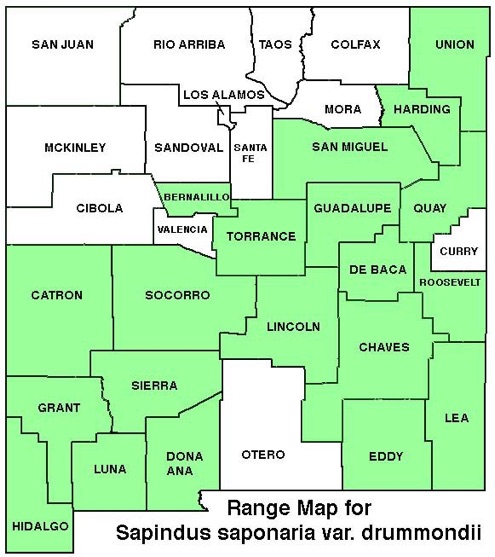WILDFLOWERS OF NEW MEXICO

Erect with one to multiple stems, this small tree typically reaches 20 feet high and can form colonies in seasonally moist soils along washes and streams. Note the large pinnate leaves, usually with an even number of smooth-edged leaflets, and the large, showy clusters of small white flowers followed by round, yellow berries.
FLOWERS: May–July. Large, open terminal clusters 6–10 inches long (15-26 cm) are packed with small, white flowers 1/4 inch wide (6 mm) with tiny 5 petals. Fruit is a fleshy, yellow-amber berry, becoming transparent 3/8–5/8 inch diameter (10–15 mm).
LEAVES: Alternate, pinnately compound. Blade 6–18 inches long (15–45 cm) with 5–7 pairs of leaflets along the central rib (rachis). Leaflets lance-shaped, 1 5/8–4 3/4 inches long, (4–12 cm); edges not toothed, surfaces thinly hairy along veins, tip pointed, often curved.
HABITAT: Sandy, rocky soils, canyons, washes, riparian areas, roadsides; desert grasslands and scrub, pinyon-juniper-oak woodlands.
ELEVATION: 3,150–6,400 feet (960–1950 m).
RANGE: AZ, CO, OK, NE, NM, TX; scattered records across southern states.
SIMILAR SPECIES: Walnuts, Juglans species, grow in similar habitats but have leaflets with serrated edges.
NM COUNTIES: Widespread in eastern and southern NM in low-elevation, seasonally moist habitats: Bernalillo, Catron, Chaves, De Baca, Dona Ana, Eddy, Grant, Guadalupe, Harding, Hidalgo, Lea, Lincoln, Luna, Quay, Roosevelt, San Miguel, Sierra, Socorro, Torrance, Union.









WESTERN SOAPBERRY TREE
SAPINDUS SAPONARIA var. DRUMMONDII (Sapindus drummondii)
Soapberry Family, Sapindaceae
Deciduous small tree or shrub









THE CONTENTS OF THIS WEBSITE ARE COPYRIGHTED AND CANNOT BE USED
WITHOUT PERMISSION OF GEORGE OXFORD MILLER
















EMAIL ME




































Soapberry trees frequently grow along arroyos and desert washes.









Specimens with single trunks make attractive xeriscape plants.
Pinnate leaves have long, lance-shaped leaflets (arrow) with smooth edges and pointed tips.

Large showy clusters of small flowers can cover the leafy canopy.
Ripe berries are yellow and transparent, usually with one seed.
















